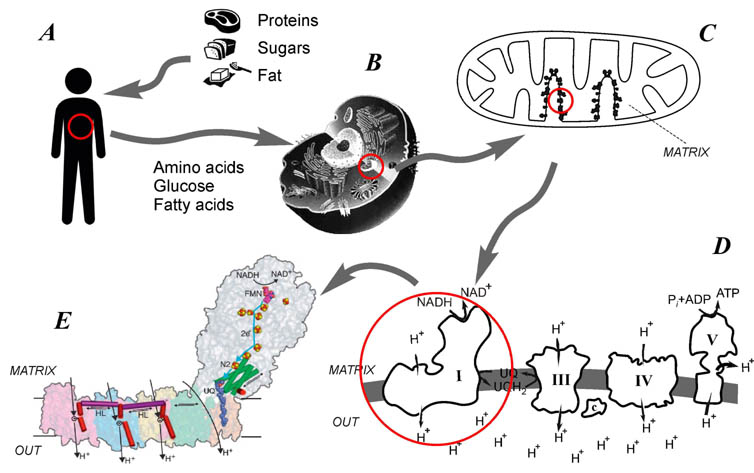 |
|
|
|
|
|
| In brief: Mitochondrial Complex I (E) is one of the largest and least understood enzymes. It is present in all cells in our body. It is responsible for the production of energy in our cells. Mutations and defects in this enzyme are associated with many pathologies: stroke, cardiac infarction, Parkinson’s disease, inherited mitochondrial disorders as well as aging. |

|
Where there’s life, there is energy. In our tissues energy is generated by specialized organelles called mitochondria (C) often referred as power stations of the cell. 90-95% of the oxygen from the air we breathe is consumed by mitochondria to produce energy during the process called cellular respiration. Cells energy currency is called ATP (adenosine triphosphate). When ATP is broken into ADP and Pi energy is released and can be used for many needs of the body such as heart beating, brain activity, kidney functioning as well as the synthesis of proteins and DNA inside all our cells. Mitochondria constantly consume oxygen and using energy coming from foodstuff to generate ATP for cellular needs (A, B).
First, we degrade everything we ate into smaller molecules and these molecules are oxidized to produce NADH (nicotinamide adenine dinucleotide). This molecule is a carrier of “high-energy” electrons in the cell. Mitochondrial Complex I is the only enzyme that can take these electrons from NADH and derive energy stored in there. This is one of the most important and least understood key components of the mitochondria and it initiates the processes of energy production during respiration of the cell. The structure of the mammalian enzyme was not known until recently. In August 2016 two groups, one of Judi Hirst from Cambridge, UK and another of Leonid Sazanov from Vienna, Austria published almost completely resolved structures for bovine (cow) and ovine (sheep) enzyme. Structure of human complex I
The mitochondrial enzyme is a huge molecule composed of at least 45 (!!) different proteins. Its’ L-shaped molecule sits in the membrane so that one arm is exposed outside and another arm is embedded into the membrane. Each time, in the exposed arm two electrons (e-) from
With other members of the respiratory chain (complexes III and IV) |
||
|